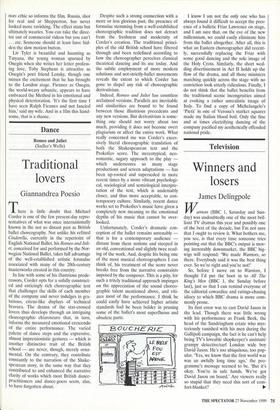Dance
Romeo and Juliet (Sadler's Wells)
Traditional lovers
Giannandrea Poem
There is little doubt that Michael Corder is one of the few present-day repre- sentatives of what was once internationally known in the not so distant past as British ballet choreography. Not unlike his refined Cinderella, currently in the repertoire of English National Ballet, his Romeo and Juli- et, conceived for and performed by the Nor- wegian National Ballet, takes full advantage of the well-established artistic formulae associated with many of the 20th-century masterworks created in this country.
In line with some of his illustrious prede- cessors, Corder opts for a solidly construct- ed and enticingly rich choreographic text that challenges the skills of each member of the company and never indulges in gra- tuitous, circus-like displays of technical bravura. The drama of the star-crossed lovers thus develops through an intriguing choreographic chiaroscuro that, in turn, informs the measured emotional crescendo of the entire performance. The varied palette of dance steps and the expressive, almost impressionistic gestures — which is another distinctive trait of the British school — are never, though, merely orna- mental. On the contrary, they contribute constantly to the narration of the Shake- spearean story, in the same way that they contributed to and enhanced the narrative clarity of works which most British dance- practitioners and dance-goers seem, alas, to have forgotten about. Despite such a strong connection with a more or less glorious past, the presence of formulae stemming from a well-established choreographic tradition does not detract from the freshness and modernity of Corder's creation. The traditional princi- ples of the old British school have filtered through and been redefined according to how the choreographer perceives classical theatrical dancing and its use today. And the subtle employment of more modern solutions and not-strictly-ballet movements reveals the extent to which Corder has gone to dispel any risk of choreographic derivativism.
Indeed, Romeo and Juliet has countless acclaimed versions. Parallels are inevitable and similarities are bound to be found between those illustrious precedents and any new versions. But derivativism is some- thing one should not worry about too much, providing it does not become overt plagiarism or affect the entire work. What really concerned me was Corder's exces- sively literal choreographic translation of both the Shakespearean text and the Prokofiev score. The stereotypical, neo- romantic, sugary approach to the play — which underscores so many stage productions and screen adaptations — has been up-rooted and superseded in more recent times by a more vibrant psychologi- cal, sociological and semiological interpre- tation of the text, which is undeniably closer, and thus more acceptable, to con- temporary culture. Similarly, recent dance works set to Prokofiev's music have given a completely new meaning to the emotional depths of his music that cannot be over- looked.
Unfortunately, Corder's dramatic con- ception of the ballet remains untenably — that is for a contemporary audience — distant from these notions and steeped in an old, conventional and slightly twee read- ing of the work. And, despite his being one of the most musical choreographers I can think of, his treatment of the score never breaks free from the narrative constraints imposed by the composer. This is a pity, for such a tritely traditional approach impinges on the appreciation of the sound choreo- graphic talent mentioned above, and viti- ates most of the performance. I think he could easily have achieved higher artistic standards had he been bolder in pruning some of the ballet's most superfluous and obsolete parts. I know I am not the only one who has always found it difficult to accept the pres- ence of a balletic Friar Lawrence on stage, and I am sure that, on the eve of the new millennium, we could easily eliminate him from the ballet altogether. After all, this is what an Eastern choreographer did recent- ly, successfully replacing the Friar with some good dancing and the sole image of the Holy Cross. Similarly, the short wed- ding divertissement in Act II holds up the flow of the drama, and all those ministers marching quickly across the stage with no conviction look utterly ridiculous. Finally, I do not think that the ballet benefits from the traditional scenic incongruities aimed at evoking a rather unrealistic image of Italy. To find a copy of Michelangelo's 'PietA' in one of Verona's market squares made my Italian blood boil. Only the fine and at times electrifying dancing of the company pacified my aesthetically offended national pride.


























































































 Previous page
Previous page